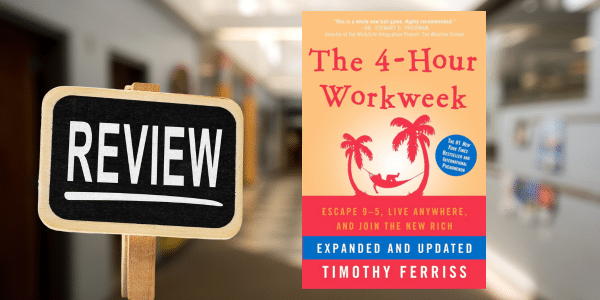Unpacking “The 4-Hour Workweek” by Tim Ferriss
In theory, only having to work four hours a week sounds nice, right? But in actuality, most people are often glorifying the hustle and grind of working 80+ hours a week to escape the typical 9-to-5. Tim Ferriss presents a refreshing perspective on success and lifestyle design in “The 4-Hour Workweek.”
Ferriss, an entrepreneur, author, and podcaster, challenges conventional notions of work and life, advocating for a more efficient and intentional approach to achieving one’s goals.
I hope you enjoy this book review of “The 4-Hour Workweek” by Tim Ferriss. Let’s dive deeper into the key insights and takeaways from this groundbreaking guide to escaping the 9-to-5 and creating a life of freedom.
If you would like to get your hands on the book, click here to read it.
1. The New Rich: Redefining Success Through “The 4-Hour Workweek”
At the core of “The 4-Hour Workweek” is the concept of the New Rich—individuals who prioritize time and experiences over money and possessions. Ferriss challenges the traditional definition of success that revolves around accumulating wealth and deferring enjoyment until retirement. Instead, he proposes a model where individuals design their lives to experience richness in the present.

The New Rich, according to Tim Ferriss, value mobility, experiences, and the freedom to pursue their passions. By redefining success in terms of time and lifestyle, rather than purely financial metrics, individuals can create a more fulfilling and meaningful existence.
2. The 80/20 Principle: Maximizing Results with Minimal Effort
Ferriss introduces the 80/20 Principle, also known as the Pareto Principle, as a critical component of the 4-hour workweek philosophy. The principle states that 80% of results come from 20% of efforts. Tim Ferriss encourages readers to identify and focus on the most impactful activities that yield the greatest results, rather than getting bogged down by less productive tasks.
By applying the 80/20 Principle to both work and personal life, individuals can optimize their time and achieve more with less effort. Ferriss emphasizes the importance of being selective and strategic in choosing where to invest time and energy for maximum impact.
3. Outsourcing and Automation: Liberation from Routine Tasks
A central theme in “The 4-Hour Workweek” is the concept of outsourcing and automation to liberate oneself from routine and time-consuming tasks. Ferriss shares strategies for delegating responsibilities, whether in business or personal life, to virtual assistants and automation tools. By leveraging the capabilities of others and technology, individuals can reclaim time for activities that align with their priorities.
Tim Ferriss provides practical tips on hiring virtual assistants, streamlining communication, and automating repetitive processes. This outsourcing approach enables individuals to focus on high-impact tasks and enjoy more leisure time without sacrificing productivity.
Personally, I’ve found this to be a huge asset to my businesses. I look at tasks that I would consider managerial or admin and then delegate that work to someone else on my team. If I can show them how to do the task and what needs to be done, it can free up a ton of my time and allow me to put my focus and productivity toward things that are higher level.
4. Mini-Retirements: Embracing Life Now
Challenging the traditional notion of retirement as a distant goal, Ferriss introduces the concept of “mini-retirements.” Rather than waiting until the end of one’s career to enjoy extended periods of leisure, Ferriss advocates for taking breaks throughout life to explore new interests, travel, and recharge.
By embracing mini-retirements, individuals can integrate periods of rejuvenation and exploration into their lives at regular intervals. This approach challenges the narrative that success is synonymous with constant work and delayed gratification, offering a more balanced and fulfilling alternative.
5. Fear-Setting: Confronting and Overcoming Fears
“Fear-Setting” is a powerful exercise introduced by Tim Ferriss to address and overcome fears that may be holding individuals back from pursuing their goals. Similar to goal-setting, fear-setting involves clearly defining and analyzing fears, assessing the potential consequences of taking action, and identifying strategies to mitigate risks.
Ferriss argues that the fear of the unknown or failure is often more paralyzing than the actual risks involved. By systematically deconstructing and addressing fears, individuals can gain clarity, build resilience, and take bold steps toward creating the life they desire.
Conclusion: Designing a Life of Freedom Like Tim Ferriss
“The 4-Hour Workweek” by Tim Ferriss is not just a book about business; it’s a manifesto for redefining success, optimizing productivity, and designing a life of freedom. Through the principles of the New Rich, the 80/20 Principle, outsourcing and automation, mini-retirements, and fear-setting, Ferriss provides readers with a roadmap for creating a life that aligns with their values and priorities.
In conclusion, “The 4-Hour Workweek” challenges individuals to question societal norms, reassess their goals, and take intentional steps toward a more fulfilling and liberated life. Ferriss’ philosophy encourages a shift from the traditional concept of success to a more holistic and personally meaningful definition. Through the pages of this book, readers are invited to embark on a journey of self-discovery, productivity optimization, and the pursuit of a life that goes beyond the constraints of the 9-to-5 grind.
Click here to get “The 4-Hour Workweek” by Tim Ferriss.
Check out some of our other book reviews that you may be interested in:
- Relentless (Tim Grover)
- Your Next Five Moves (Patrick Bet-David)
- Crush It! (Gary Vaynerchuk)
- The 10X Rule (Grant Cardone)
- Rework (Jason Fried)
- The Halo Effect (Phil Rosenzweig)
- Built To Last (Jim Collins)
- Only the Paranoid Survive (Andrew Grove)
- Atomic Habits (James Clear)
- Can’t Hurt Me (David Goggins)
- Jab, Jab, Jab, Right Hook (Gary Vaynerchuk)
- Good To Great (Jim Collins)


*Disclosure: This article may contain affiliate links or ads, which means we earn a small commission at no extra cost to you if you make a purchase through these links. These commissions help support the operation and maintenance of our website, allowing us to continue producing free valuable content. Your support is genuinely appreciated, whether you choose to use our links or not. Thank you for being a part of our community and enjoying our content.
PLEASE CONSIDER SHARING THIS ON YOUR SOCIAL MEDIA TO HELP OTHERS LEARN MORE ABOUT THIS TOPIC.





